
Wrinkly face, boxy body, short muzzle, and a curly tail – you know it’s a Pug when you see it! These are a few of the distinct physical traits Pugs have that make them a very recognizable breed. They are often described as the clowns of the canines with their easy-going personalities, sense of humor, and love of people. They are a toy breed that was bred to be a companion dog and their favorite place will be on your lap. They might not require hours of exercise but they certainly have the stamina and curiosity to keep them going for longer than you might imagine. Pugs have been popular for over a century and continue to be a favorite breed with their gentle, social nature.
Did You Know?
- Pugs can be difficult to house train. They can be very stubborn at first and it is highly recommended that they be crate trained.
- Pug people are as enthusiastic as their dog companions; they plan get-togethers to let their Pugs play, dress them up to show them off, and have even held Pug parades.
- Pugs’ eyes are very prominent on their face and as a result are more prone to eye injuries.
- Pugs do not adapt well to hot or highly humid places. As air goes through a dog’s nose it cools down, but Pugs have very short muzzles so there is not a lot of opportunities for air to cool down. They are more prone to overheating or heat stroke when they are outside during the hot summer months. Keep a close eye on your Pug if he is out during the heat of the day.
- Pugs are greedy little eating machines. If you don’t carefully monitor how much they eat, they will quickly gain too much weight and become obese. Carefully monitor their food intake because they will eat whatever you give them.
- Pug’s short muzzles contribute to their sneezing a lot, and their loud snoring. So when he wants to sleep in bed with you, be prepared to listen to him snore all night.
Breed Characteristics
Adaptability

Adapts Well to Apartment Living: 5/5
Good for Novice Owners: 5/5
Tolerates Being Alone: 1/5
All-Around Friendliness

Affectionate with Family: 5/5
Dog-Friendly: 4/5
Friendly Toward Strangers: 4/5
Health Grooming

Amount of Shedding: 5/5
Easy to Groom: 5/5
General Health: 1/5
Trainability

Easy to Train: 3/5
Intelligence: 2/5
Tendency to Bark or Howl: 2/5
Exercise Needs

Energy Level: 3/5
Exercise Needs: 3/5
Potential for Playfulness: 5/5
 History
History
Pugs have enjoyed living with royalty since their first days in China. Their appearance has been dated as far back as 200 B.C., found in China with various Emperors through multiple Dynasties. Pugs enjoyed a life of luxury living in grand accommodations and at times even having their own soldiers to guard them. It is thought that they may come from the Tibetan mastiff. Ancient pugs have been found in Tibet as well as Japan. Pugs fall under one of the three short muzzled dogs bred by the Chinese, the Lion Dog, the Pekingese, and the Lo-sze, Pugs are related to the Lo-sze.
As trade between China and Europe began in the latter 16th century, it is believed that this was when Pugs were first introduced to Europe. The common belief is that the first Pugs came home with Dutch traders after their visit to China, they named the breed Mopshond. Not surprisingly, Pugs became a favorite breed among many royal families in Europe as well. A Pug named Pompey reportedly saved the life of the Prince of Orange, later to become William III, by warning of assassins. William III and Mary II took their Pugs with them when they claimed the throne of England. Needless to say, Pugs were in the Royal spotlight form early on and quickly gained a following among many throughout all of Europe.
Many portraits that were painted during this time of Royal and aristocratic families include their Pugs. Masters such as Goya, Hogarth, and Chalon have pieces with Pugs painted in them. Even the military used Pugs to a degree during this time. Some other very influential names you might recognize that gave rise to the popularity of the Pug are Josephine Bonaparte, wife of Napolean. She wrote a concealed message to her family and had her Pug deliver them. Queen Victoria had many Pugs, which she herself bred. She was a large reason for the establishment of the Kennel Club. She was very involved with multiple breeds, but Pugs were among her favorite. This was passed down to King George V, and King Edward VIII.
As the Pug gained popularity across Europe he went by a variety of names including; Carlin in France, Dogullo in Spain, Mops in Germany, and Caganlino in Italy. No matter what you call him, the compact bodied, short-muzzled, wrinkly-faced, affectionate companion is a Pug.
Pugs as we know them today came largely from a single Pug named Click that was bred form two “pure” Chinese Pugs that were brought back from China to England. Multiple other Pugs were bred with Click that developed the look of the Pug as we know him today. Prior to this new generation of Pugs, they had longer legs and a longer muzzle, typically with cropped ears. That style of Pug was bred out once the “pure” Pugs from China were bred into the other lines.
Pugs didn’t make their debut in America until after the Civil war. Like everywhere else the Pug quickly made his way into the hearts and homes of Americans. He is a fabulous participant in the show ring as well. The last Pug to win World Champion or Best in Show was in 2004.
Size
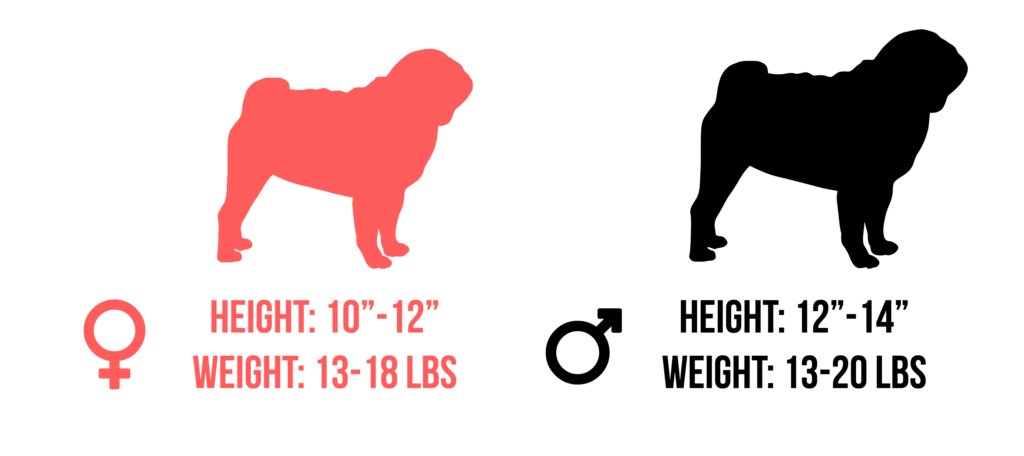 Healthy Pugs weigh in around 14 to 18 pounds. Males are slightly heavier than females. They typically stand about 10 to 14 inches tall at the shoulder.
Healthy Pugs weigh in around 14 to 18 pounds. Males are slightly heavier than females. They typically stand about 10 to 14 inches tall at the shoulder.
Appearance
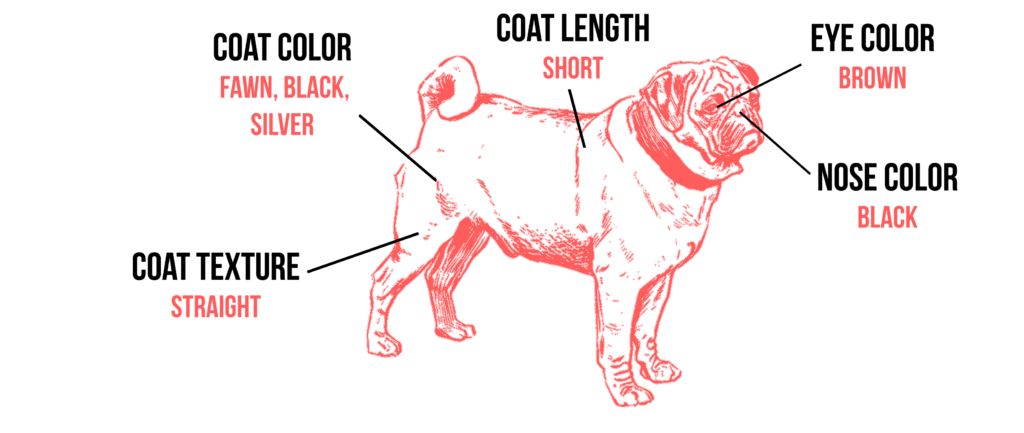 A Pug’s colors and markings are very standardized. Their coat can be fawn colored or black. The fawn colored coat can be tinted apricot or silver. All Pugs have a black mask across their short, flat muzzle. Their coat is short and glossy, but all Pugs have a double coat, meaning lots of shedding. A Pug’s head should be large and round with large, round dark eyes that are very expressive. A Pug should not be leggy or long in the body, they are a compact breed that is symmetrical and cobby in appearance.
A Pug’s colors and markings are very standardized. Their coat can be fawn colored or black. The fawn colored coat can be tinted apricot or silver. All Pugs have a black mask across their short, flat muzzle. Their coat is short and glossy, but all Pugs have a double coat, meaning lots of shedding. A Pug’s head should be large and round with large, round dark eyes that are very expressive. A Pug should not be leggy or long in the body, they are a compact breed that is symmetrical and cobby in appearance.
Behavior
Personality
Have you seen the many pictures of Pugs dressed up in costumes? Well, that should give you an idea of his personality; he is fun-loving, easy going, but also a dignified dog. They do not hunt, retrieve, or even guard. They are your devoted companion, meant to give and receive affection and sit on your lap whenever they get the chance. They love to play and be the clown to get attention from everyone in the room. They won’t be winning any receiving or agility trophies but they will make you laugh and be your best friend.
Pugs are easy to train, especially if you reward them with a favorite treat. They can be a bit stubborn to house train, but if you learn to read their body language and reward them appropriately they will respond well. For optimal training, start to train your puppy as soon as he comes home. Those that wait until they are 6 months old will have a much more stubborn and headstrong dog to work with.
Children and Pets
Pugs love children and children love Pugs. Pugs are a small breed but not delicate, so they make a great companion for families with younger children. If your child wants a dog that will play Frisbee or soccer with them, well Pugs just aren’t going to do that. As with any dog, interactions between him and children should be supervised. Children need to be taught how to handle and respect him, even if he is a calm and social dog. If he is socialized from a young age, he can get along well with other dogs, cats, and rabbits.
Health
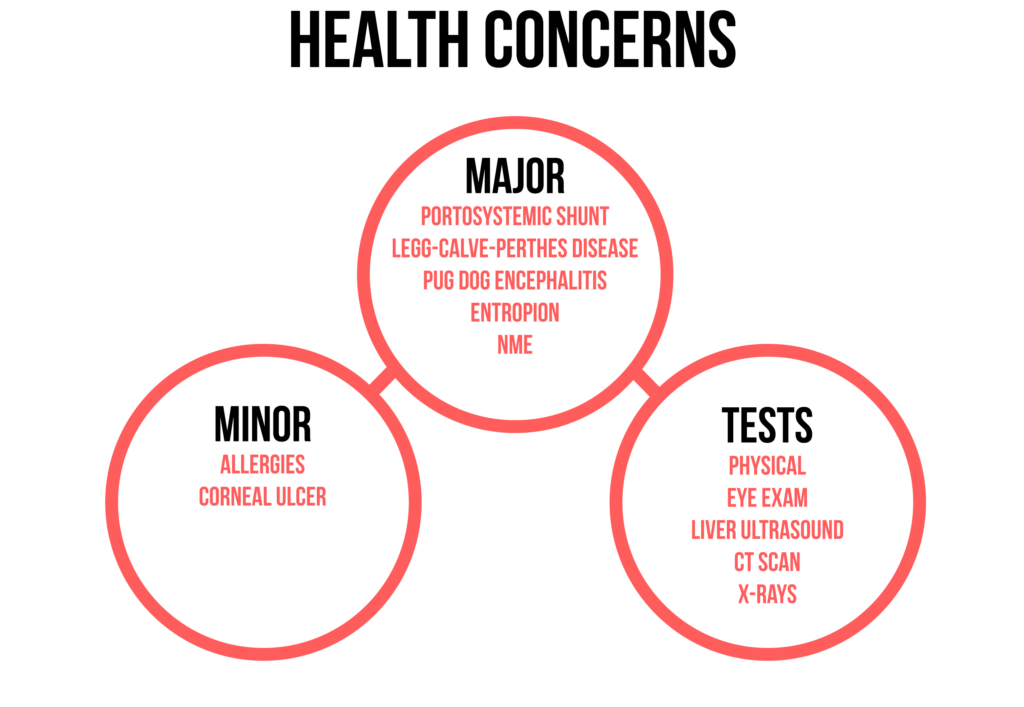 Pugs are generally a fairly healthy breed but as with all breeds, there are some health conditions they are more prone to. They do not have any major health problems but can be born with medical conditions or acquire conditions as they age. It is important to note that not all Pugs will have any or all of these conditions but it is good to be aware of possible health conditions they may have. If you have access to your dog’s parental health records, that would be a great place to do some research and see what he may be prone to having. You can obtain health clearances for both of the parents of your dog to make sure they’ve been tested and cleared from the following conditions. Health clearances can be confirmed by checking the Orthopedic Foundation for Animals (OFA) website. Be sure to purchase from a responsible breeder that tests for health conditions in all the dogs they breed and provide vaccines and deworming prior to taking him home.
Pugs are generally a fairly healthy breed but as with all breeds, there are some health conditions they are more prone to. They do not have any major health problems but can be born with medical conditions or acquire conditions as they age. It is important to note that not all Pugs will have any or all of these conditions but it is good to be aware of possible health conditions they may have. If you have access to your dog’s parental health records, that would be a great place to do some research and see what he may be prone to having. You can obtain health clearances for both of the parents of your dog to make sure they’ve been tested and cleared from the following conditions. Health clearances can be confirmed by checking the Orthopedic Foundation for Animals (OFA) website. Be sure to purchase from a responsible breeder that tests for health conditions in all the dogs they breed and provide vaccines and deworming prior to taking him home.
Hip Dysplasia: This is a genetic condition passed down from parents in which the femur does not fit snugly into the pelvic socket of the hip joint. This condition can exist without clinical signs so it is important to have X-ray screenings done. Dogs with this condition can be in pain and exhibit lameness in one or both rear legs. Ask the breeder for proof that the parents were tested and cleared for hip dysplasia.
Epilepsy: Another hereditary disorder, this causes seizures. It cannot be cured but it can be controlled with medication. Pugs that suffer from Epilepsy can live long healthy lives with proper management.
Patellar Luxation: This is a common condition in smaller dogs. This occurs when the patella (kneecap) does not line up properly with the Tibia and or Femur. This causes the kneecap to slip in and out of place causing minor to severe pain. This is a condition that occurs at birth but the symptoms may not appear until much later in a more mature dog. The rubbing of the kneecap can lead to arthritis or degenerative joint disease. Minor luxation causes brief lameness in that leg while major luxation is when it can no longer be aligned manually and may require surgery to correct it.
Legg-Perthes Disease: This condition is common in toy breeds, and involves the hip joint. This occurs when the blood supply to the head of the femur decreases until the head of the femur that connects to the pelvis begins to disintegrate. This can be painful and usually occurs when a puppy is 4 to 6 months old. Luckily, a veterinarian can surgically remove the dead part of the femur and then the scar tissue connects to the pelvis instead. Dogs can live normal active lives free of pain after this corrective surgery.
Cheyletiella Dermatitis: Also known as walking dandruff. This is a skin condition that is caused by a small mite that causes dry skin and dandruff. If you notice more than the usual amount of dandruff in the middle of your dog’s back, get him to the vet. This is contagious and can be easily treated to prevent it from spreading.
Pug Dog Encephalitis: This condition, known as PDE, is a fatal brain condition that affects only Pugs. It is an inflammatory brain disease that is fatal. Currently, there is no known cause or treatment for this condition. The only way to confirm a diagnosis is testing the dog’s brain tissue following his death. This disease affects young Pugs causing symptoms of seizures, circling, then going into a coma and dying. This can last for a few days up to a few weeks. Research is currently being done to try to find the cause and a cure for this devastating disease.
Nerve Degeneration: This is a condition that affects older Pugs with symptoms including dragging their rear, unable to jump up and down, and becoming incontinent. The cause is a degeneration of their nervous system. It is still uncertain why this occurs as the front legs remain strong. At times vets can prescribe medications to assist with this condition.
Corneal Ulcers: Pugs are more prone to eye injuries with their large prominent eyes. They can also develop ulcers on the cornea. If his eyes look red and he is tearing a lot, get him to the vet as soon as possible. This can be treated with medication. If the ulcer persists for too long he can lose his eyesight and even rupture the eye.
Dry Eye: There are two main causes of a chronic dry eye in Pugs; Keratoconjunctivitis sicca and pigmentary keratitis. Chronic dry eye occurs when your Pug does not produce enough tears on his own to keep his eyes moist. Your vet can determine what is the cause and prescribe the appropriate medication to keep his eyes moist. Pigmentary keratitis causes black spots to appear on the cornea, if gone untreated, it can cause blindness. Both conditions are easily treated but will be lifelong conditions that need daily care and treatment.
Eye Problems: With their large eyes that are so prominent, they are much more prone to eye injuries and conditions than other dog breeds. Some of these include proptosis (when the eyeball is dislodged from the eye socket with the eyelid closing behind it), Distichiasis (when eyelashes grow too close to the margin of the eye rubbing against the eye), progressive retinal atrophy (a degenerative disease that affects the retinal cells leading to blindness), and entropion (when the eyelid rolls inward and causes the eyelashes to rub against the eye).
Allergies: This is a common ailment in all dogs, they can have food allergies or contact allergies. Each is treated by eliminating whatever is causing the allergy from the dog’s diet or removing the contact item giving the dog the allergy. Inhalant allergies can also affect dogs and some can be alleviated by medications. Ear infections are a common side effect of inhalant allergies.
Staph Infection: It is common for dogs to have staph bacteria on their fur, but if it gets into their body through a cut or other open lesion they can become infected, especially if their immune system is under stress at the time. They can develop hives in the area and even appear to have ringworm. Take him to the vet as soon as possible to get the appropriate treatment.
Yeast Infection: If you notice that your Pug has a bad odor even after a good bath, check for blackened or hardened skin. Areas that usually show these signs are his armpits, groin area, neck and inside his ears. A vet can prescribe medication to clear the infection.
Hemi-Vertebrae: This condition occurs when a Pug has one or more misshaped vertebrae. It is generally noticed when he is 4 to 6 months old and they appear to be uncoordinated at running or jumping. Most Pugs can live a normal life, others may get progressively worse and require surgery.
Sensitivity to Vaccines: There are reports of Pugs being sensitive to routine vaccinations with symptoms ranging from hives to facial swelling to death. If you notice anything unusual about your dog following vaccinations, notify your vet.
Maintenance
 Care
Care
He may be a low-maintenance companion not requiring hours of intense exercise, but he does need daily exercise and he is a very curious canine. Daily walks and games will keep him happy and healthy. When they are indoors they are content to sit on your lap and follow you around. They need attention and are most definitely an indoor dog. Pugs are sensitive to heat and humidity so be aware of how much time he spends outdoors when it is hot or humid outside. Remember they live to love their owners and need to be loved in return.
Feeding
As with any dog, purchase high quality, nutrient dense dog food. Ask your veterinarian what food and blend would be best suited for your dog. Factors such as age, size, and activity level will make a difference on what kind of food he needs and how much. Typically, Pugs will need 1/2 cup to 1 cup of dry food a day. It is recommended that this amount be divided into two separate meals, one in the morning and one at night.
His first love is you, his second is food. He loves to eat, eat, eat, and if it is not carefully monitored he can quickly become overweight. You must not indulge him with food as it will put him at more health risks.
Grooming
Now to be forthright, Pugs shed like crazy. They have short smooth hair, but a double coat and they shed all year long. You will need to keep your Pug brushed regularly, and invest in a good vacuum. They can be bathed at least once a month; use a good shampoo that won’t dry his skin out. They can be bathed more frequently if necessary. Since he is a nice compact dog, he fits nicely in the kitchen sink or bathtub for his washing. As you wash him, be careful around his eyes, avoid getting any soap or shampoo in them as it could irritate them. Another thing that requires special attention is his distinct wrinkles. They need to be thoroughly dried after bathing so they do not get infected. You can use cotton balls to clean between the folds or commercial baby wipes.
His nails will need to be trimmed if he doesn’t wear them down on his own. Typically, they will need trimmed once or twice a month. If you can hear them clack on the floor when he walks, then they are too long. You can trim them or have a groomer trim them. Be aware that they do have blood vessels in their nails so if you trim them too short they will bleed and he won’t be so keen on getting them trimmed again.
Pugs also need to have their teeth brushed regularly. Ask your vet for the recommended toothpaste for your dog. Brushing regularly will help prevent gum disease.
Grooming is a great time to look over your Pug to check his overall health and appearance. Check for any sores, odors, skin conditions etc. Check his paws and pads to make sure they are healthy and free of cuts or sores as well.
Questions
Are pugs a good apartment dog?
Pugs are low-maintenance dogs, they sleep a lot, tend to be quiet, and they’re small. That makes them a good pet for apartments of any size.
Are pugs a smart dog?
Contrary to popular belief, most Pugs are smart, and can easily outsmart you. But remember, positive training and setting boundaries are necessary if you don’t want to end up with a misbehaving pup.
How long do most pugs live?
Between 12 to 15 years.
Is a pug hard to care for?
Compared to other dogs, no. They do well indoors and sleep most of the day. However, they still need exercise, so make sure to take them on daily walks. They are also prone to breathing problems due to their short muzzles, so make sure to use a harness instead of a collar+lead and keep an eye on them. They are sensitive to heat so make sure they stay hydrated and aren’t in a warm, humid climate for too long.
Resources
Unfortunately not everyone that purchases a Pug fully understands everything that goes into raising and training a well behaved, healthy Pug. There are many Pugs in need of a loving home whether that be through adoption or fostering. Below is a list of Rescue agencies that have Pugs. If you do not see a local rescue below you can contact a local or nation Pug Breed Club and ask them.
Rescue
- Green Mountain Pug Rescue
- Mid-Atlantic Pug Rescue – Home
- Muffin Pug Rescue
- Pug Rescue Network
- Pug Rescue of New England –
Breeders
- Breeder Directory – PUG DOG CLUB OF AMERICA
- Pug Puppies, Lotus Blossom Pugs
- Reputible Pug Breeders – Pug Village
- Welcome to Ugly Mugs Pugs
Pug Adults For Sale
If you’re interested in purchasing adult Pugs, click on the links below to find what you’re looking for.
Pug Puppies For Sale
If you’re interested in purchasing Pug puppies, below you will find different online marketplaces that have Rottweiler puppies for sale.
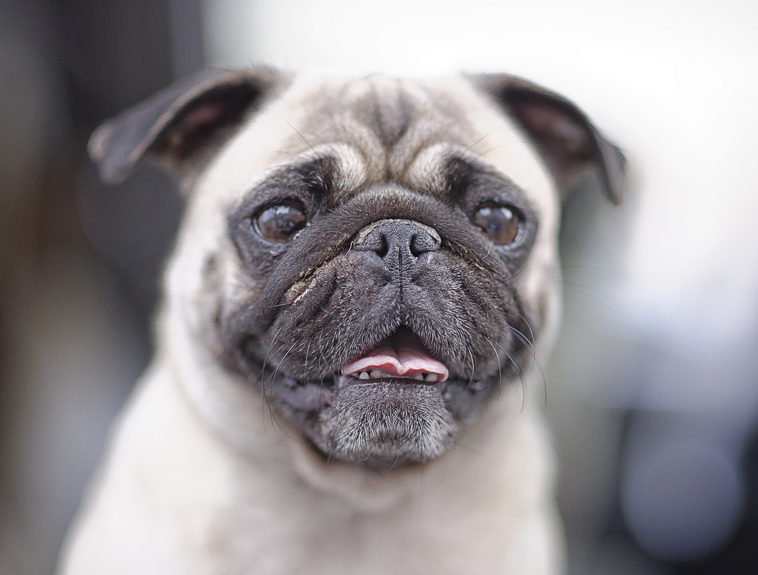
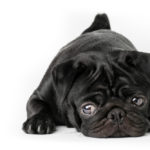
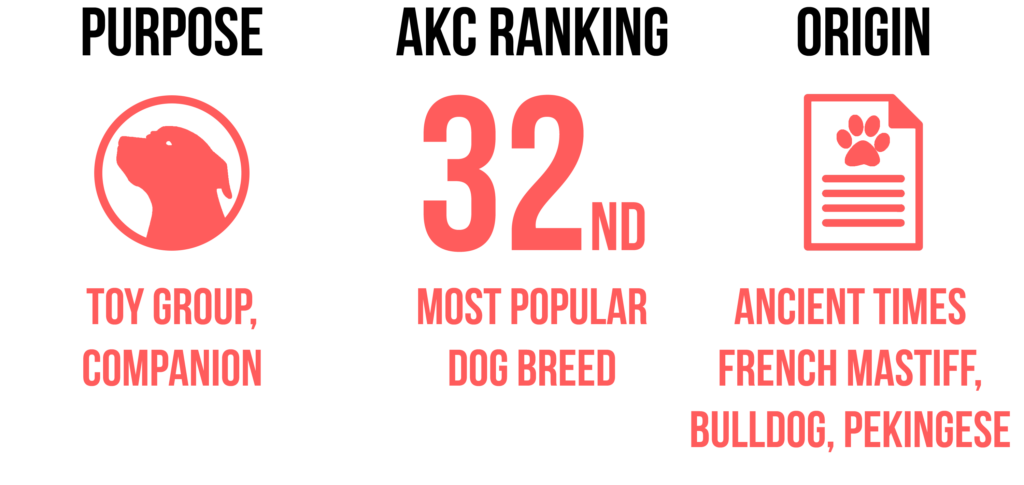 History
History Care
Care